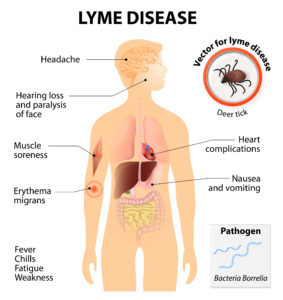 Lyme Disease is a disease carried by ticks. It is a bacterial disease carried in the saliva of an infected tick. The most common bacteria which causes Lyme Disease is called B. burgdorferi. Since it is transferred by ticks, the tick is called the “vector” for Lyme Disease.
Lyme Disease is a disease carried by ticks. It is a bacterial disease carried in the saliva of an infected tick. The most common bacteria which causes Lyme Disease is called B. burgdorferi. Since it is transferred by ticks, the tick is called the “vector” for Lyme Disease.
When you get bitten by a tick, it stays in your skin while it sucks up your blood. This process takes 48-96 hours and then the tick regurgitates the blood into the wound. It is at this point when the infected saliva enters the body and is why it is very important to remove the tick as soon as possible.
Removal of Ticks
Not all ticks are infected, and there are regional and seasonal variations. Ticks should be removed from the base, making sure that you do not squeeze the body. This would push the infected blood into the person, increasing the risk of infection. You also want to make sure that you are removing it from as close to the skin as possible. If not, then you may well leave some of the tick in the wound, and the infection can still be transmitted.
Signs and Symptoms of Lyme Disease
Signs of Lyme disease are not always that obvious and immediate. An initial sign is a bull’s eye like skin rash where the bite occurred. However, this is not always the case and can appear slightly different. Some people may have no symptoms and others may show some of the following over a period of up to a month after the bite.
Typical signs and symptoms include:
- Nausea
- Rash about 2-40 days after the infection
- Severe headaches
- Tiredness
- Flu-like conditions
- Muscle and joint pain
- Feeling generally very unwell.
If you think someone has Lyme Disease, consult a doctor immediately.
For more information on training courses, visit our “Courses” page which also includes our First Responder and First Person on Scene (FPOS) Courses.

